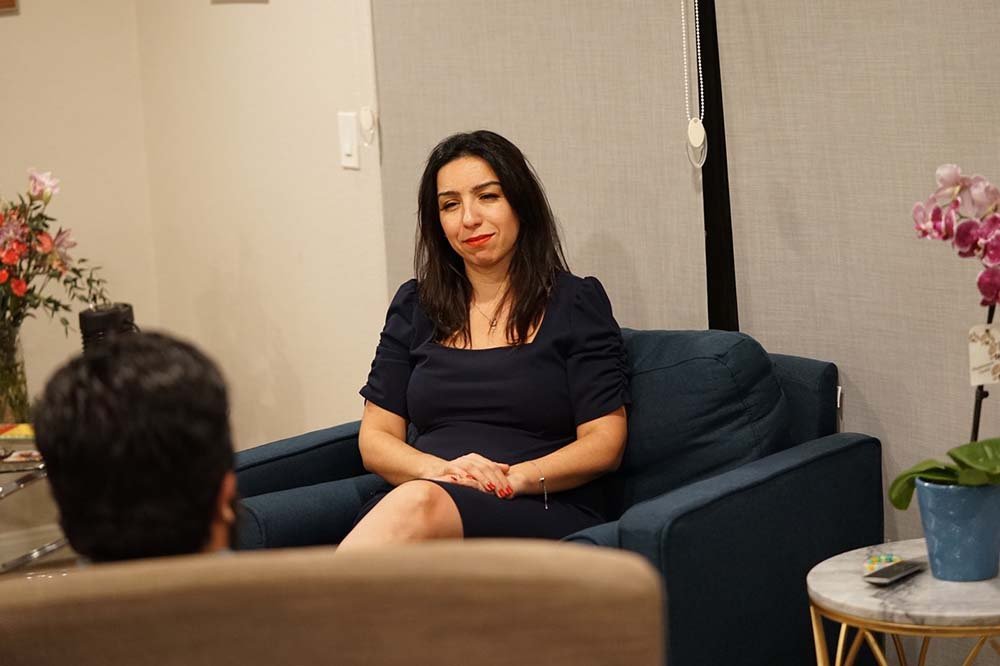What is Therapy?
Therapy can be intimidating. Talking to a stranger you have never met and telling them everything about you? What if they judge me or make me feel stupid? But at its core, Therapy is the most intimate, non-judgmental, one-sided relationship with a professional. It is the space where you come to lower your burden, find the space for containment, being heard, valued, cared about, and receive empathy and compassion, think through your own thoughts, talk about what you can’t share with others, share vulnerable and intimate details of your life you may feel embarrassed, scared, shy, or uncomfortable about, and receive care, compassion, understanding and containment.

Building Trust and Safety, I believe in therapy being a non-judgmental space as laws and ethics allow. – See limits of confidentiality. In this place, you become the most important person in the room. Your needs, ideas, values, and experiences are valid and cared about. Therapy is also a sounding board. Providing space for you to share your own thoughts and ideas, hear yourself and think through them, and ultimately, find solutions that you seek on your own.
As the therapeutic relationship deepens, Therapy can also be the space of guidance, interpretation, and feedback. After building a trusting relationship with the therapist, you get to hear their perspective, alternative views, the ways in which your past, generational trauma and intergenerational events could have impacted you, your loved ones and those who impacted you. You get to see how the different layers of home, school, community, culture, government, etc. affects one’s day-to-day life and experiences.
Through this process, you will be able to recognize the interwovenness of our experiences as people. In that we can gain empathy for ourselves and others, find freedom to make changes and create movement on a bigger scale. Therapy can lead to personal, professional and cultural freedom as it helps us become free of the unspoken, misunderstood patterns that affected us and impacted our lives.
Because of this journey, Insight is one of the most significant and powerful tools that can give us that knowledge and understanding. It is important to understand where your issues came from and why they exist, so that we can work through them and reduce their influence on your present life. Through this deep exploration and understanding of ourselves, we can learn to manage our present feelings, behaviors, and relationships better. Psychodynamic therapy is a collaborative process that encourages clients to reflect on their inner experiences and promote self-awareness, leading to significant and positive changes in their lives.
Before Your First Session
Before your first session, you will likely receive the paperwork from your therapist explaining their policies, gathering important information, including name, address, emergency contact, method of payment, and reason for visit. Some therapists will provide you a more detailed questionnaire to complete about your concerns, your past history, relationship history, etc. to help them move through the assessment quickly. Some therapists will complete the assessment in session and will ask those questions when you are in front of them.

Along with policies and identifying information, you are usually provided with the information about missed sessions, cost of therapy, billing arrangements, limits of confidentiality and your rights as a patient.
Therapists often explain that therapy is voluntary and that at any time if you are unhappy with your services you can terminate your sessions or ask to be referred to someone else. However, it is preferable to discuss your concerns with your therapist as they may be able to help solve the issue you have with them. In any case, you are always in therapy at will. There is no sexual relationship of any kind allowed in therapy.
For your first session, the therapist will let you know if they need any documents from you including driver’s license, to verify name, address and the person who is coming to the session. Sometimes, therapists complete all of these tasks before first session.
For example, in our office, Heal and Thrive Psychotherapy and Coaching, we contact the client within 24 hours after calling us for therapy and provide them with the needed paperwork. The paperwork can be filled online. If the client has any problems accessing the forms, we are happy to help. You will be asked to provide your documents, i.e. driver’s license, insurance card, etc. We require the paperwork to be completed prior to the session. If not able to complete the paperwork, we can reschedule the appointment if we have been told within 24 hours.
During Your First Session
First session can range from 50 min to 60 min. Therapy sessions are usually 50 min.
In your first session, you will review the consent form you signed if it hasn’t already happened and you will be asked if you have any questions.
Moving into the session, you will start with discussing why you are seeking therapy at this time, what are the events and symptoms that lead to therapy at this point, what are you hoping to get out of therapy, what is your history with mental health treatment, successes, not so great experiences and why, which modalities you have used if you know.
The therapist usually will discuss their method of treatment, what they will do in the session, i.e. skill building, training, psychoeducation, exploration and reflection, assigning homework, being a sounding board, providing support etc. The therapist usually will explain the theoretical model or models they are using to treat you.
During the assessment, we will explore your symptoms, your background, family history, medical, mental health, substance abuse and addiction history if any, traumas or significant events in the past or currently, and current functioning in different areas such as work, education, family, friends, relationships, financial if relevant, and any other areas if you like to discuss.
Finally, we will ask what are your goals for treatment and together with a therapist, you will start to create your goals, how you will achieve those goals and the techniques that will be used.
At Heal and Thrive Psychotherapy and Coaching, we use different modalities including CBT, DBT, ADHD Coaching, Trauma informed treatments, using many modalities including psychodynamic, processing techniques, somatic experiencing, meditation, relaxation, grounding, attachment theory, building healthy relationships, creating a safe environment for processing, making sense of and gaining new insight about experiences and being able to create new narratives or ways of understanding that will be more helpful and freeing from past experiences.
Important Considerations The therapist can give a mental health diagnosis at the end of the first session assessment. It is required for submitting the claim to an insurance company but not if the client is cash pay and does not want a diagnosis.
Managing Session Time The therapist tries very hard to stay within the limits of the session and will help the client make transitions, reminding them of the time remaining, maybe asking client to take notes or the therapist taking notes about what to be discussed in the next session. Therapist also asks the client not to open up new topics at the end of the session if there is not enough time and will ask to cover the topic in the next session. Therapist works very hard to make sure the client does not leave the office completely dysregulated. However, that can happen and the therapist usually provides resources for the client to use outside of the session.
Preparing for Your Session In preparation for the first session, the client should think about what they want to work on in therapy and be ready to express that. The client can write down important information they want to make sure they share with the therapist. Other than that, unless the therapist asks for it, the client doesn’t need to bring anything. The client can choose to bring something to take notes if they want.
After Your First Session: The Therapy Journey

Based on the modality used, therapy can take from 6 weeks to years. It depends on the modality used, client’s symptoms and what they want to work on and the depth of work being done.
For shorter term work, treatment usually focuses on one aspect, one issue or problem. Something like a young adult having trouble adjusting to college life. But other than that, having had quite a healthy background and life and no other difficulties at this time.
On the other hand, it can take years when addressing complex intergenerational trauma, mistreatment, and difficulties stemming from childhood experiences leading to unhealthy relationships and negative view of self.
Therapy can be adjusted to the client’s needs, what they want to focus on and what they want to accomplish at this time. Sessions occur based on client and therapist ideas of what’s needed. It can be multiple times a week to every few months. Often times, it’s weekly, bi-weekly or monthly.
Measuring Progress, Progress is tracked based on the theory used and what’s being treated. Progress in psychodynamic work is seen as the level of depth achieved, insights received and how far the client can process in increasing their self-understanding that later can affect their perspective of others and in turn the way they engage with others. That can affect how they are perceived, the relationships they have with family, friends and work and the kind of opportunities that arise as a result. In a CBT context, progress may be evaluated based on reducing symptoms or changes in behaviors that were focus of therapy.
An Important Note In therapy, you are likely to get worse before you get better. That’s because you have to uncover what’s troubling you before you can start changing it and the process can be difficult but you are not alone and have a trained professional to guide, support, contain and help you through it.

Psychotherapy is a valuable space
Psychotherapy is a valuable space that provides safety, non-judgment, and trust, where individuals have the opportunity to discuss and explore what they wish. In this therapeutic relationship, we focus on improving various aspects of your life, including but not limited to, reducing stress, worry, sadness, anxiety, depression, relationship and trust issues, parenting stress, and work stress, as well as enhancing self-esteem and self-worth.
I practice psychodynamic therapy, a method that aims to help you unearth the root causes of your worries, struggles, fears, and stressors by examining past experiences and their influence on present behaviors, feelings, and relationships. This type of therapy allows us to delve deep into the underlying/root causes, bringing about long-lasting change.
It is important to understand where your issues came from and why they exist, so that we can work through them and reduce their influence on your present life. Through this deep exploration and understanding of ourselves, we can learn to manage our present feelings, behaviors, and relationships better. Psychodynamic therapy is a collaborative process that encourages clients to reflect on their inner experiences and promote self-awareness, leading to significant and positive changes in their lives.

Pingback: